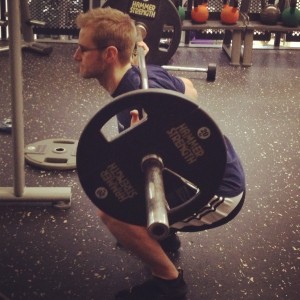Compound and Isolation Exercises
Compound and Isolation Exercises
In order to design a successful and safe exercise programme, a working knowledge of compound and isolation exercises are a must. The correct mixture of both can be the difference between success and failure.
This article outlines the each category and explains the benefits of each.
Compound Exercises
Compound exercises are big, multi-joint exercises such as Bench Presses, Squats and Deadlifts. The multi-joint aspect can be explained by describing the amount of movement through various joints and the nature of the lift. Our joints are manipulated by muscle tissue contracting, which pulls on tendons, ultimately forcing movement at the joint. The exercises that involve movement at multiple joints recruit large amounts of muscle tissue.
The classic example of a compound exercise is the Squat, which forces the body to provide force and push a load through the ankles, knees, hips and back. The weight is held across the back (on the shoulder blades) and the trainee bends down towards the floor (keeping the back straight, bending the legs) and slowly pushes the weight back up, using control the whole time. This one exercise alone incorporates all of the lower-body musculature, as well as the core in order to be successful. It is little wonder the squat is known as the ‘king’ of all exercises.
Compound exercises are the key to any muscle-building training regimen as they train a large area of muscle in a short amount of time. By training large areas of muscle in a session the body releases more anabolic hormones, ultimately resulting in more muscle being built! The fact that larger areas of muscle are being trained also translates into less gym time, reducing the overtraining risk.
I have discussed elsewhere on the site the science of muscle building, so it is clear to see the role that hormones have on the muscle growth process. Given their significant influence in the process, it makes sense we should use hormonal responses to exercise in our training for particular goals. It isn’t cheating, its sensible training.
A thorough resistance training programme will usually consist of at least 80% compound exercises.
Common Compound Exercises
- Bench press
- Squats
- Chins
- Dips
- Deadlifts
- Lunges
- Military Press
- Bent-Over Rows
- The Olympic Lifts (Cleans, Snatch etc)
Isolation Exercises
Isolation exercises are commonly referred to as ‘single joint’ exercises as they only train a small area of muscle by manipulating one joint. The classic example here is the bicep curl. The movement is performed by bending the arm from a straightened starting point. As the arm bends, the bicep muscle group contracts. Isolation exercises only train small areas of muscle so do not trigger a large hormonal response from the body.
Isolation exercises are a topic attracting lots of discussion in weight training circles, with two distinct groups formed – those who believe in their effectiveness as a training tool and those who don’t. The reason they are so polarising is simply because they are not really necessary in order to train the body – a well designed programme of compound exercises will ensure all of the body muscles are trained thoroughly.
Those in the anti-isolation camp deem them pointless as they don’t contribute much hormonally and are not necessary providing the correct compound lifts are used, so why bother? The other side, those who do use isolation exercises argue that by isolating a muscle you can thoroughly train it, rather than rely on it being hit as part of a non-specialised approach.
At a physiological level, it is incredibly difficult to isolate a muscle. Muscles work in unison to move joints, provide stability, distribute load and maintain structure. Our musculature is designed to work in pairs and groups, so trying to isolate individual muscles is not only difficult, it could even be viewed as unnatural!
This debate has raged for years and will continue to do so. The problem here is that both camps have a fairly rational argument on paper, although I side with the compound lifters as the science supports the protocol, plus I am big fan of efficiency – if I can achieve my desired results with 5 exercises, why would I perform 10?!
Common Isolation Exercises
- Bicep Curl
- Tricep Extension
- Leg Curl
- Lat Raises
- Calf Raises
- Hammer Curls
- Tricep Kickbacks
- Leg Lifts
The Hoyles Fitness View?
Call it sitting on the fence, being a wuss or whatever you want – I don’t subscribe fully to either camp. The vast majority of my training is with compound exercises, so I sit firmly on their edge of the continuum. The science is more credible and the results are impossible to ignore. More importantly, I enjoy compound exercises and they work well for me. That said, I also use isolation exercises to ensure muscles that are not targeted well enough with compound exercises are thoroughly worked.
I think it is unwise to totally ignore isolation exercises, as they can provide much-needed boosts to muscles that are being particularly stubborn to growth from compound lifts alone. Used correctly they are also an excellent rehabilitation option. These are important factors that shouldn’t be ignored – training is the means to achieving a goal, and that goal isn’t necessarily always size-based.
Finally it comes down to what you enjoy. I am of the belief that if you enjoy doing something you are more likely to stick at it. If you enjoy compound exercises, do them – you won’t have to do a bicep curl or a tricep extension for the rest of your training life if you so wish! If you enjoy isolation exercises, do the same. It may take you two hours to complete a session, but if you enjoy it, do it.
Don’t be a slave to any one method – use whatever tools work for you.


2 thoughts on “Compound and Isolation Exercises”